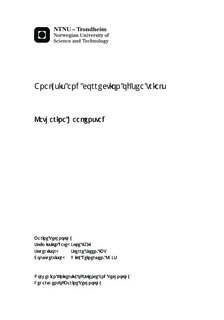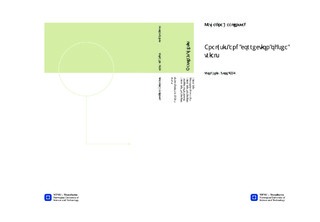| dc.description.abstract | When a ship-owner orders a vessel from a shipyard, a contract is written to confirm and guarantee the agreement for both parts. An important requirement of the contract is the vessel's speed at a given engine power, RPM and draught, in "ideal" conditions (i.e. calm, infinitely deep and current free water, with smooth hull and propeller surfaces at with no wind and zero drift and rudder angle). The speed capacity of the recently built ship is measured carrying out a speed trial. It is rarely possible to perform the trial under ideal, contractual conditions, and the speed will normally be reduced by environmental factors. Whenever the test is carried out in conditions deviating from those contractually specified, the speed must be corrected for, to best coincide with the contractual stipulations. These corrections can be of significant magnitude and are of great economic importance. Penalties of considerable size are given to shipyards that fail to deliver in accordance with the contract. There are various standards published providing guidelines regarding the execution of speed trials, the measurements that are to be performed during the trials and corrections for environmental factors that are to be made in retrospect. ISO (2002), Perdon (2002), Bose (2005) and B. Henk (2006) were chosen for evaluation and comparison in this thesis. The recommendations of the standards are occasionally disagreeing.The main resistance contribution is claimed to be wind and wave (Bose (2005) and B. Henk (2006)). B. Henk (2006)) states; "these corrections (small displacement deviations, shallow water, and salinity deviations) are relatively small compared to wind and wave directions". Reinertsen (2011) suspects that the added wave resistances calculated by the Hyundai shipyard are too large. This assumption is based on Haugan (2011)'s (employee of KGJS) mean wave load calculations that generally gave results 30 % lower than those found by Hyundai. An unrealistically large correction factor for wave resistance is most definitely advantageous for the shipyard. This will give a higher calculated contractual speed, and the shipyard is consequently more likely to meet the contractual requirements. The Hyundai shipyard's correction procedures were evaluated based on the relevant standards. The shipyard neglects all resistance components, but the added resistance due to wind and waves (they also correct for large discrepancies between the trim/draught obtained at speed trial and that contractually stipulated. This is however not relevant for tankers, as these generally are capable of achieving design draught at the sea trial). This is consistent with the recommendations of Perdon (2002) and B. Henk (2006). The shipyard does not have the speed trials conducted in head - or following waves, nor head - or following wind. B. Henk (2006) and Perdon (2002) underline the importance of executing the speed trials in head - or following waves. Perdon (2002) argues; "in the case when the waves do not come from the bow or the stern the correction methods are not sufficiently reliable and the effects of steering and drift on the ship's performance may be underestimated". ISO (2002) recommends performing the trials in head and following wind (note that there usually is a correlation between true wind - and wave direction).The Hyundai shipyard assumes that the wave direction with respect to the ship's centerline equals the relative wind angle. This conflicts with the recommendations of the standards. They advise to obtain the wave direction by visual observations or instruments such as buoys or sea wave analysis radars. Furthermore, Hyundai's assumption is highly illogical from a scientific standpoint. In this thesis, the added wave resistance (due to diffraction) was computed by a handful of methods proposed in the literature. The computed values obtained in this report were all substantially larger than those found by Hyundai. This denies Reinertsen (2011)'s suspicion of Hyundai's correction factors for wave resistance being unrealistically high. B. Henk (2006) emphasizes the importance of accounting for the location of the anemometer in the computations of added resistance due to wind. This is not done by the shipyard. B. Henk (2006) proposes a formula for correction of improper placements of the anemometer. In this thesis, the added wind resistance was calculated, including this correction. The added resistance found was 28 % smaller than the value obtained by Hyundai. This is relevant as the wind tends to be a key resistance contribution.Finally, the Energy Efficiency Design Index (EEDI) has been described. The EEDI estimates a ship's CO2 emission per ton-mile of goods transported; put differently, the vessel's impact on the environment in relation to its benefit for society. The EEDI is to be implemented for all new ships, 1st of January 2013. The value of this index will be determined based on results from speed trials. | nb_NO |

